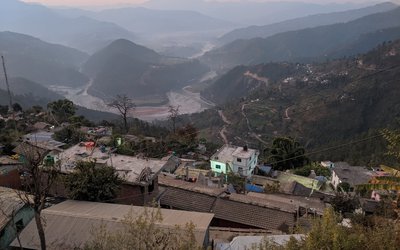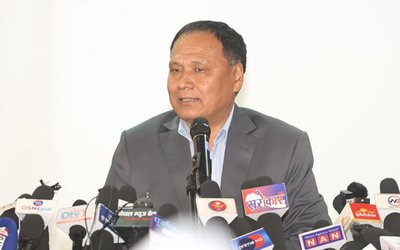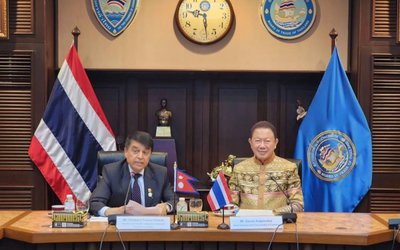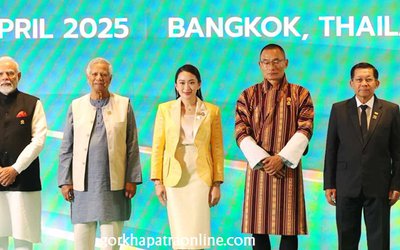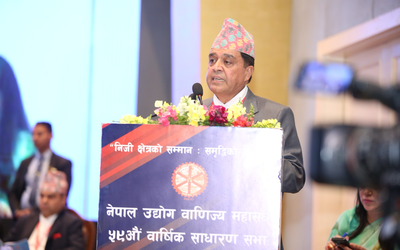
Although Nepal has taken several steps including the banning the import of a number of luxury items to end the pressure on foreign currency reserve, the result is opposite. Nepal’s trade deficit has widened during the last three months.
According to NRB, the current account deficit has widened by Rs. 49.78 billion in a month from mid-March to mid-April 2022. Similarly, gross foreign exchange reserves decreased by 16.5 per cent to Rs. 1167.92 billion in mid-April 2022 from Rs. 1399.03 billion in mid-July 2021. It was Rs. 1171 billion in mid-March. However, the purchasing power of the foreign exchange has remained the same over the months.
"Based on the imports of nine months of 2021/22, the foreign exchange reserve of the banking sector is sufficient to cover the prospective merchandise imports of 7.4 months, and merchandise and services imports of 6.6 months," said the NRB.
In the previous month, the foreign exchange reserve of the banking sector was sufficient to cover such imports for 7.4 months and 6.7 months respectively.
The current account remained at a deficit of Rs. 512.71 billion by mid-April compared to a deficit of Rs. 462.93 billion in mid-March, according to the 'Current macroeconomic and financial situation' report of the NRB. Report of the first nine months of the current fiscal year 2021/22 was published recently. Such deficit was Rs. 210.51 billion in the same period of the previous year 2020/21. The current account deficit was in upward trend that year as well, it widened by Rs. 59.09 billion in a month from mid-March to mid-April 2021.
Likewise, Balance of Payments (BOP) remained at a deficit of Rs. 268.26 billion by mid-April against the deficit of Rs. 258.64 billion in mid-March. BOP was in a surplus of Rs. 42.54 billion in the same period of the previous year.
The central bank has implemented a cash margin while opening the Letter of Credit (LC) of various luxury goods and the government has restricted the import of 10 goods to prevent the foreign exchange reserves from further depletion.
During the nine months of 2021/22, merchandise imports increased by 32.0 per cent to Rs. 1466.66 billion compared to an increase of 13.1 per cent a year ago. Of the total imports, the share of intermediate goods remained 53.2 per cent, capital goods 10.5 per cent and final consumption goods remained 36.3 per cent in the review period.
Likewise, merchandise exports increased by 69.4 per cent to Rs. 160.57 billion compared to an increase of 20.2 per cent in the same period of the previous year.
In the 9-month period, capital transfer decreased by 39.5 per cent to Rs. 7.78 billion and net foreign direct investment (FDI) increased by 33.7 per cent to Rs. 16.51 billion. In the same period of the previous year, capital transfer and net FDI amounted to Rs. 12.86 billion and Rs. 12.35 billion respectively, read the NRB report. Capital transfer witnessed a growth compared to the previous month – it was Rs. 7 billion in mid-March.
Inflation in upward trend
With the escalation of price of petroleum products, the consumer price inflation has continued its upward trend in mid-April and reached 7.28 per cent, up from 7.14 per cent in mid-March. In mid-April 2021, consumer price inflation was 3.10 per cent.
By mid-April, food and beverage inflation stood at 7.40 per cent whereas non-food and service inflation stood at 7.18 per cent in the review month. Average inflation remained at 5.62 per cent during the review period.
The prices of ghee and oil, milk products and eggs, pulses and legumes, and tobacco products rose by 28.36 per cent, 11.56 per cent, 10.53 and 8.91 per cent respectively on year-on-year basis. Likewise, prices of transportation, education, and miscellaneous goods and services rose by 20.16 per cent, 8.79 per cent and 8.17 per cent respectively.
In the review month, the Kathmandu Valley, Terai, Hill and Mountain witnessed 6.25 per cent, 7.61 per cent, 7.79 per cent and 8.25 per cent inflation respectively. Inflation in these regions was 3.24 per cent, 2.92 per cent, 3.38 per cent and 1.54 per cent respectively a year ago.
Remittance inflow improves
Remittance inflow witnessed an improvement in the ninth months of this year compared to the eighth months before. It decreased by 0.6 per cent to Rs. 724.74 billion by mid-April against a decrease of 1.7 per cent to Rs. 631.19 billion previously. Remittance inflow had increased by 16.5 per cent in the same period last year.
Similarly, number of Nepali workers taking approval for foreign employment increased significantly to 256,031 in the review period up from 227,900 by mid-March.
The recent data published by Nepal Rastra Bank has shown that Nepal’s economy has been passing through a very difficult time. There is a need to take further precautions.
- NEPAL-THAILAND: Joint Business Council
- Apr 13, 2025
- BIMSTEC SUMMIT: Nepal’s Stand
- Apr 11, 2025
- IME GROUP: Expands Into Paper Industry
- Mar 24, 2025
- CPN UML: Instigated By India
- Mar 23, 2025
- ADB’S CHIEF ECONOMIST: Nepal Reduces Poverty
- Mar 11, 2025
